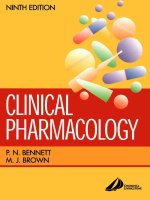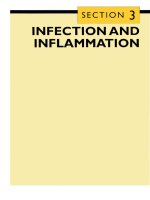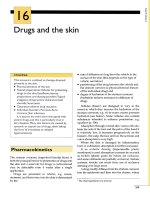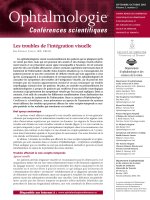Clinical Transfusion Medicine - part 1 ppt
Bạn đang xem bản rút gọn của tài liệu. Xem và tải ngay bản đầy đủ của tài liệu tại đây (220.44 KB, 18 trang )
V
m
Clinical
Transfusion
Medicine
Joseph D. Sweeney
Yvonne Rizk
a d e m e c u
V
LANDES
BIOSCIENCE
a d e m e c u m
Table of contents
(excerpt)
1. Introduction
2. Allogeneic Blood Products
3. Autologous Blood Products
4. Epidemiology of Blood Transfusion
5. Informed Consent and Explanation of
Blood Options
6. The ABO and Rhesus System
7. Compatibility Testing and the Importance
of Proper Recipient Identification
8. The Administration of Blood Products
9. Blood Transfusion in Surgery I: Ordering
Practices and Transfusion Styles
10. Blood Transfusion in Surgery II: Cardiac
and Vascular Surgery
11. Blood Transfusion in Surgery III:
Orthopedic and Urologic Surgery
This is one of a new series of medical handbooks.
It includes subjects generally not covered in other handbook series, especially
many technology-driven topics that reflect the increasing influence of technology
in clinical medicine.
The name chosen for this comprehensive medical handbook series is Vademecum,
a Latin word that roughly means “to carry along”. In the Middle Ages, traveling
clerics carried pocket-sized books, excerpts of the carefully transcribed canons,
known as Vademecum. In the 19th century a medical publisher in Germany, Samuel
Karger, called a series of portable medical books Vademecum.
The Landes Bioscience Vademecum books are intended to be used both in the
training of physicians and the care of patients, by medical students, medical house
staff and practicing physicians. We hope you will find them a valuable resource.
All titles available at
www.landesbioscience.com
LANDES
BIOSCIENCE
Clinical Transfusion
Medicine
Sweeney
Rizk
LANDES
BIOSCIENCE
12. Blood Transfusion in Surgery IV: Blood
Transfusion in Solid Organ Allografts
13. Blood Transfusion in Surgery V: General
Surgery
14. Blood Transfusion in Surgery VI: Trauma
and Massive Blood Transfusion
15. Blood Transfusion in Medicine I: Cancer
16. Blood Transfusion in Medicine II: Bone Marrow
Transplantation
17. Blood Transfusion in Medicine III: Hereditary
Anemias
18. Blood Transfusion in Medicine IV: Renal Disease
19. Blood Transfusion in Medicine V: Patients
with Acute Gastrointestinal Bleeding
20. Blood Transfusion in Medicine VI: Patients
Infected with Human Immunodeficiency Virus
ad em e c um
V
Joseph D. Sweeney, M.D.
The Miriam and Roger Williams Hospitals
Brown University School of Medicine
Providence, Rhode Island
Yvonne Rizk, M.D.
Women and Infants Hospital
Providence, Rhode Island
Clinical Transfusion Medicine
A
USTIN
, T
EXAS
U.S.A.
vademecum
L A N D E S
B I O S C I E N C E
VADEMECUM
Clinical Transfusion Medicine
LANDES BIOSCIENCE
Austin
Copyright © 1999 Landes Bioscience
All rights reserved.
No part of this book may be reproduced or transmitted in any form or by any
means, electronic or mechanical, including photocopy, recording, or any
information storage and retrieval system, without permission in writing from
the publisher.
Printed in the U.S.A.
Please address all inquiries to the Publisher:
Landes Bioscience, 810 S. Church Street, Georgetown, Texas, U.S.A. 78626
Phone: 512/ 863 7762; FAX: 512/ 863 0081
ISBN: 1-57059-494-5
Library of Congress Cataloging-in-Publication Data
While the authors, editors, sponsor and publisher believe that drug selection and dosage
and the specifications and usage of equipment and devices, as set forth in this book, are in
accord with current recommendations and practice at the time of publication, they make
no warranty, expressed or implied, with respect to material described in this book. In
view of the ongoing research, equipment development, changes in governmental regula-
tions and the rapid accumulation of information relating to the biomedical sciences, the
reader is urged to carefully review and evaluate the information provided herein.
Sweeney, Joseph, 1952-
Clinical transfusion medicine / Joseph D. Sweeney, Yvonne Rizk.
p. cm.
"Vademecum."
Includes bibliographical references and index.
ISBN 1-57059-494-5
1. Blood Transfusion handbooks, manuals, etc. I. Rizk, Yvonne. II. Title.
[DNLM: 1. Blood Transfusion Handbooks. WB 39 S974c 1999]
RM171.S926 1999
615'.39 dc21
DNLM/DLC 99-24311
for Library of Congress CIP
Contents
Section A: General
1. Introduction 1
2. Allogeneic Blood Products 4
3. Autologous Blood Products 9
Predeposit Autologous Blood (PAD) 9
Preoperative Hemodilution or Preoperative Apheresis 10
Intraoperative Salvage 11
Postoperative Salvaged Blood 11
Autologous Stem Cells 12
4. Epidemiology of Blood Transfusion 14
5. Informed Consent and Explanation of Blood Options 16
6. The ABO and Rhesus System 20
7. Compatibility Testing and the Importance
of Proper Recipient Identification 23
8. The Administration of Blood Products 28
Section B: Surgery
9. Blood Transfusion in Surgery I: Ordering Practices
and Transfusion Styles 31
10. Blood Transfusion in Surgery II:
Cardiac and Vascular Surgery 35
11. Blood Transfusion in Surgery III:
Orthopedic and Urologic Surgery 39
12. Blood Transfusion in Surgery IV:
Blood Transfusion in Solid Organ Allografts 43
Kidney Transplantation 44
Liver Transplantation 45
Heart Transplantation 46
Lung Transplants 46
13. Blood Transfusion in Surgery V: General Surgery 47
14. Blood Transfusion in Surgery VI:
Tr auma and Massive Blood Transfusion 51
Section C: Medicine
15. Blood Transfusion in Medicine I: Cancer 55
Hematological Malignancies in Adults 55
Pediatric Malignancies 57
16. Blood Transfusion in Medicine II:
Bone Marrow Transplantation 59
Autologous Stem Cell Transplants 59
Allogeneic Stem Cell Transplants 60
17. Blood Transfusion in Medicine III:
Hereditary Anemias 63
Sickle Cell Syndromes 63
Thalassemic States 66
18. Blood Transfusion in Medicine: IV: Renal Disease 68
19. Blood Transfusion in Medicine V:
Patients with Acute Gastrointestinal Bleeding 72
20. Blood Transfusion in Medicine VI: Patients Infected
with Human Immunodeficiency Virus 74
21. Blood Transfusion in Medicine VII: Hereditary
and Acquired Bleeding Disorders 76
Hereditary Bleeding Disorders 76
Acquired Bleeding Disorders 78
22. Blood Transfusion in Medicine VII:
Autoantibodies to Red Cells and Platelets 82
Red Cell Autoantibodies 82
Platelet Autoantibodies 84
23. Blood Transfusion in Medicine IX:
Using Drugs to Reduce Blood Transfusion 87
Hormones or Hormone Derivatives 87
24. Blood Transfusion in Obstetrics 91
25. Fetal and Neonatal Transfusion 95
Fetal Transfusions 95
Neonatal Transfusions 95
Neonatal Thrombocytopenia 96
Section D: Appropriate Prescribing
26. Clinical Decisions and Response Monitoring:
Triggers, Targets, Functional Reserve
and Threshold of Effect 99
27. Red Blood Cells: Indications and Dosing 103
28. Platelets: Indications and Dosing 107
29. Plasma and Cryoprecipitate: Indications and Dosing 112
Plasma 112
30. Leukocytes, Indications and Dosage 117
31. Blood Derivatives: Indications and Dosage 120
Section E: Complications
32. Acute Complications of Blood Transfusion 123
Life Threatening Acute Complications 123
Non-Life Threatening Acute Complications of Blood Transfusion 128
33. Delayed and Late Complications
of Blood Transfusion 131
Delayed Blood Transfusion Reactions 131
Late Complications 133
34. Blood Transfusion Transmitted Infections I: Viruses 135
Viruses 135
35. Blood Transfusion Transmitted Infections II:
Bacteria, Protozoa, Helminths and Prions 140
Section F: Special Products
36. Special Blood Product I:
Leukoreduced and Washed Blood Products 145
37. Special Blood Products II:
Irradiated Blood Products and Transfusion
Associated Graft Versus Host Disease 149
38. Special Blood Products III:
Cytomegalic Virus Low Risk Blood Products
and the Prevention of Primary CMV Disease 153
39. Special Blood Product IV: Frozen Blood 156
40. Special Blood Products V: Therapeutic Phlebotomy,
Apheresis and Photopheresis 158
Therapeutic Phlebotomy 158
Therapeutic Apheresis 159
Photopheresis 162
41. Blood Transfusion in the 21st Century 163
APPENDIX 165
Index 167
Preface
Clinical transfusion medicine is an evolving subspecialty, which straddles
traditional areas of pathology and clinical hematology. This subspeciali-
ties is concerned with aspects of blood procurement, including safety, lo-
gistics and economics, and the appropriate use of blood products in dif-
ferent clinical situations. This causes the transfusion medicine physician
to interact with (and occasionally come into conflict with!) surgeons, an-
esthesiologists, internists, and many subspecialists in internal medicine,
particularly, oncologists and hematologists. The resultant of this interac-
tion should be improvement in blood utilization. In short, the role of
clinical transfusion medicine is to promote good transfusion practice.
Promoting good transfusion practice is often hindered by a lack of good
clinical data validating many current transfusion practices. Confounding
this problem is the often entrenched belief in the clinical usefulness of
many traditional transfusion practices. The transfusion medicine physi-
cian is, therefore, frequently put in the position of altering practices, a
precarious role in any institution!!
This short book is intended to put clinical problems in perspective as
they relate to decision making regarding blood transfusion. It is aimed at
nursing staff, perfusionists, nurse practitioners, physician assistants and
medical students and residents, many of whom lack depth in their under-
standing of transfusion. The language is kept as nontechnical as possible
therefore, and detail is intentionally omitted. However, it is hoped that
the background information and general principles should facilitate the
exercise of good judgment.
Joseph D. Sweeney, M.D.
Yvonne Rzik, M.D.
Providence, Rhode Island
May, 1999
Acknowledgments
The expert assistance of Ms. Susan Sullivan in the preparation of this
monograph is gratefully acknowledged.
10
Clinical Transfusio n Medicine
1
Introduction
The scope of transfusion medicine can be separated into two definable areas
of activity (Fig. 1.1). First, there are those activities concerned with the manufac-
ture of blood products. These processes occur mostly in Community Blood Centers
or Fractionation plants. The ‘source material’ is obtained from healthy human
subjects, known as blood donors. This part of transfusion medicine is concerned
with the collection, processing, and testing of blood donations and the mainte-
nance of an inventory of blood products prior to shipping to sites of transfusion.
The kinds of activities are similar to those which occur in standard pharmaceuti-
cal houses. Emphasis is on the potency, safety, efficacy, and purity of the manufac-
tured blood products.
The second area of transfusion medicine can be described as clinical transfu-
sion medicine. Clinical transfusion medicine is concerned with aspects related to
the transfusion of blood products to recipients. The human subjects of interest
are sick patients, and called blood transfusion recipients. Emphasis is on product
availability, appropriateness of use, informed consent, compatibility testing, ad-
ministration of blood, monitoring for adverse events (called transfusion reactions)
and the long term follow up for complications of infectious disease. These differ-
ences are shown in Table 1.1 but are really a continuum, as illustrated in Figure 1.1.
This book is concerned with the second area of transfusion medicine i.e., clinical
transfusion medicine. Brief reference will be made to manufacture, however, where
background information is important. Clinical transfusion medicine mostly oc-
curs in a hospital setting, although other sites of transfusion are becoming com-
monplace, such as outpatient departments, renal dialysis units, physician offices
or even the recipient’s home. Within the hospital structure, the focal area for this
activity is the blood bank. Although blood banks are concerned with the dispens-
ing of a therapeutic product, they are often part of pathology laboratories. From a
theoretical perspective it would be more appropriate if blood banks were more
closely linked to hospital pharmacies. A comparison of pathology laboratories,
blood banks, and pharmacies in Table 1.2 illustrates this point. The historical rea-
son for blood banks to be within departments of pathology, and not part of a
pharmacy, primarily relates to the need to perform compatibility testing as this
testing is similar to other kinds of tests traditionally performed by laboratory
technologists.
The purpose of this book is to serve as a quick source of useful, practical infor-
mation for the many aspects of clinical transfusion medicine. The content reflects
practice in the United States, but is generally applicable to other countries. Knowl-
edge of transfusion medicine is surprisingly limited even among experienced he-
matologists and pathologists and a simple rapidly readable text serves a useful
Clinical Transfusion Medicine,
by Joseph D. Sweeney and Yvonne Rizk. © 1999 Landes Bioscience
11
1
Introduction
Ta ble 1.1. Comparison of the major areas of activities in transfusion medicine
Manufacture of Clinical transfusion
blood products medicine
Site Blood center or plasma Blood bank/
fractionation plant transfusion service
Activity Manufacture of blood Transfusion of blood
components and derivatives components and derivatives
Regulatory FDA JCAHO
agencies/ AABB AABB
accrediting (USA) CAP
organizations
Product Defined General terms
specifications
Va r iation in Minimal Large variations
practices in techniques/and
between sites practices
Auditing of Standard Variable; often not
practices performed
Human Healthy subjects Ill Subjects
population (blood donors) (blood recipients)
Product focus Potency; efficacy; Availability; appropriateness
safety; purity; of use and administration
effectiveness adverse events
FDA = Food and Drug Administration
AABB = American Association of Blood banks
JCAHO = Joint Commission on Hospital Accreditation
CAP = College of American Pathologists
Fig. 1.1. Activities in blood centers and transfusion services. Product quality is the focus
of blood centers; clinical outcome is the focus of transfusion services.
12
Clinical Transfusio n Medicine
1
need. It is divided into sections, each consisting of short chapters which can be
read within five minutes addressing specific clinical situations, and facilitation of
rapid clinical decision-making or giving essential background information are
the objectives of the book. It is not intended as a reference text in transfusion
medicine, therefore, and the readership is aimed at medical students, residents in
training, or nursing and allied health personnel. Chapters are, therefore, inten-
tionally short without specific references. When more detailed information on a
specific clinical situation is required, it is suggested that an electronic search be
conducted or reference textbooks such as may be conveniently available in the
Blood bank should be consulted. Suggested sources of information with more
detail are given in the Appendix.
Ta ble 1.2. Comparison of diagnostic pathology laboratories, blood banks and
pharmacies
Pathology Laboratories Blood banks Pharmacies
Product Diagnostic Therapeutic Therapeutic
Personnel Te c hnologists/ Technologists/ Pharmacists
Te c hnicians Technicians
Specialist Pathologists Pathologists/ Clinical
Physicians Hematologists Pharmacologists
Regulatory/ CAP; CAP; AABB; JCAHO;
Accrediting JCAHO JCAHO; FDA FDA
Agencies
CAP = College of American Pathologists; AABB = American Association of Blood banks
JCAHO = Joint Commission on Hospital Accreditation; FDA = Food and Drug
Administration
13
2
Allogeneic Blood Products
Allogeneic Blood Products
The term allogeneic refers to blood products manufactured from blood dona-
tions from healthy subjects (blood donors) which are intended for transfusion to
different subjects (blood recipients). In the past these products were called “ho-
mologous”, but the current preferred term is allogeneic, in order to be consistent
with solid organ transplantation terminology. Other names used regionally to
describe these products are; “regular blood”, “shelf blood” or “banked blood”.
The term Blood Product, then, is an all embracing term used to describe any
end-product produced from human blood. First, there is whole blood, which is
collected into a solution that functions both to anticoagulate and preserve the red
blood cells. These are simple solutions containing citric acid to chelate calcium
and, therefore, prevent activation of the coagulation system and glucose to allow
red cells to metabolize during in vitro storage (e.g., citrate-phosphate-dextrose or
CPD). Adenine may also be present (CPD-A1), which improves red blood cell
adenosine triphosphate (ATP) levels. Anticoagulated whole blood is collected into,
stored in, and transfused from, its primary container. Although whole blood was
commonly used prior to the 1970s, this has diminished over the past decades. The
two remaining clinical situations where whole blood is still preferentially requested
for transfusion are patients with trauma requiring multiple transfusions and car-
diac surgery, particularly pediatric cardiac surgery. This is because it has been
suggested that ‘fresh’ whole blood (less than 48 hours old) may be preferable to
correct any coagulopathy which may develop in these patients . However, the prac-
tical logistics of having fresh whole blood routinely available makes this difficult
to achieve in practice.
Second, most whole blood donations are further processed by centrifugation
into a number of blood components. Each whole blood donation is capable of pro-
ducing up to five different components, but commonly, either red blood cells and
plasma, or red cells, plasma and platelets are produced. Further processing of a
unit of plasma can produce a unit of cryoprecipitate and a cryosupernatent, the
latter known as cryo poor plasma. Some fibrin glue preparations are similar to
cryoprecipitate, except that the process may be modified to enhance fibrinogen
yields (see Chapter 23). In practice, almost all allogeneic whole blood donations
are processed into at least two components, such as a red cell concentrate and
plasma. The red cell concentrate can be stored in the anticoagulant plasma alone
(CPD red blood cells; CPD-A1 red blood cells), or a crystalline solution can be
added, which contains glucose and stabilizers to maintain the quality of red cells
during the storage period (Adsol®, Nutricell®, or Optisol®). The maximum dura-
tion of storage for red cells (at 1-6°C) under such circumstances is currently 42
days (Chapter 27). Much of the plasma produced from the whole blood dona-
Clinical Transfusion Medicine,
by Joseph D. Sweeney and Yvonne Rizk. © 1999 Landes Bioscience
14
Clinical Transfusio n Medicine
2
tions is shipped to fractionation plants for further manufacture into blood de-
rivatives. Some of the plasma, however, is retained in blood centers in the frozen
state and used for clinical transfusion purposes (see Chapter 29).
A single unit of platelets may also be produced from each blood donation.
Although the terminology is confusing, a platelet unit derived from a whole blood
donation is commonly known as a random donor platelet. A separate type of
blood component is an apheresis blood component. Several different types of
apheresis components are available but the most important is the platelet apheresis
product, commonly known as single donor platelets. As indicated above, a unit of
random donor platelets is also derived from a “single donation” and hence the
terminology is confusing (Chapter 28). Other allogeneic apheresis products may
be more widely available in the future, as a ‘double unit’ of red cells, or combina-
tions of platelets and red cells, or red cells and plasma, may be obtained from a
single donor using these devices. It is anticipated that many such products will be
approved for use by late 1999. The hallmark of a blood component is that is de-
rived from a single donation. Each such donation has a unique identification (unit
number or lot number).
Third, there are blood products known as blood derivatives. These are manu-
factured from a plasma pool usually containing between 5,000 and 20,000 dona-
tions. This plasma pool constitutes a new lot number, composed of the individual
lot numbers of each donation which makes up the pool. All blood derivatives in
current use are acellular products. Derivatives in common use are 5% or 25%
albumin, immunoglobulins, and the plasma derived coagulation factor concen-
trates. Since blood derivatives are produced from such a large number of blood
donations, there is always the ongoing concern that new viruses from apparently
health donor(s), may enter each pool and potentially infect a large number of
recipients. This was responsible for the spread of hepatitis in the 1970s and, sub-
sequently, human immunodeficiency virus (HIV-1) in the 1980s in the hemo-
philic population. Blood derivatives are routinely subjected to a variety of pro-
cessing steps. Some of these steps are intentionally performed to destroy viruses,
which is called viral attenuation. Use of at least two different types of viral attenu-
ation processes is now common in order to optimize the destruction of viruses.
Examples of these processes are pasteurization i.e., heating to 60°
C
for ten hours;
various separation steps, e.g., gel filtration or micro-filtration, and chemical treat-
ments such as solvent detergent exposure. In spite of the clear effectiveness of
these viral attenuation processes, there is still the potential for some viruses to be
resistant to these steps and result in the infection of blood transfusion recipients.
The last type of allogeneic blood product is stem cell products. Stem cells can
now be collected from a number of sources, other than the traditional bone mar-
row, such as peripheral blood or umbilical cord blood. Allogeneic stem cell prod-
ucts are always derived from a single donor, but multiple donations may be re-
quired if peripheral blood is the source. Since stem cells are generally transfused
in specialized transplant units, they will not be described further and the reader is
15
2
Allogeneic Blood Products
referred to the Clinical Handbook of Bone Marrow Transplantation for further in-
formation on these products and associated technology. These products are il-
lustrated in Figure 2.1.
The physical state of blood products during storage varies with the product
type. Red cells and platelets are typically stored in the liquid state. Plasma and
cryoprecipitate are stored in the frozen state. Certain blood products are manu-
factured and stored in the lyophilized state; examples are some immunoglobulin
preparations and coagulation factor concentrates. However, red cells (or less com-
monly platelets) may also be stored in the frozen state using cryoprotective agents;
and certain blood derivatives, such as one preparation of immunoglobulin and all
albumin preparations, are stored in the liquid state. All products are transfused as
a liquid product, either after thawing of frozen products or reconstitution of lyo-
philized products. This accounts for the delay in availability since it takes between
15-30 minutes to either thaw frozen products, or to reconstitute lyophilized prod-
ucts prior to transfusion. This is shown in Table 2.1.
The allogeneic blood supply in the United States, much of Europe and Japan is
predominantly collected from what are known as ‘volunteer blood donors’. These
donors donate for altruistic reasons and do not receive any remuneration or re-
ward of a material monetary value. Platelet pheresis donors in some centers re-
ceive a token remuneration. However, much of the plasma collected for fraction-
ation comes from paid donors. A different type of volunteer blood donor is known
as a directed donor, and the donation as a ‘directed donation’. Directed donor
blood products are allogeneic blood products which meet all the requirements for
Figure 2.1. Allogeneic blood products
Source: Healthy Humans
Donors
Donation ( = individual lot #)
Products: Whole blood
(single donation)
Blood components Red Blood Cells
(single donation) -plasma → cryoprecipitate; cryo poor plasma
-platelets
-apheresis components
Blood Derivatives Albumin
(5,000-20,000 Immunoglobulins
donations) Coagulation Factors
Stem Cells Bone Marrow
(single/multiple Peripheral Blood
donations) Umbilical Cord
Fetal Hepatocytes
Physical State Liquid (e.g., red cells, platelets)
Frozen (e.g., plasma)
Lyophilized (e.g., derivatives)
16
Clinical Transfusio n Medicine
2
a standard allogeneic blood product. However, they differ in that the intended
recipient is identified at the time of donation. The practice of directed blood do-
nation is often performed in the context of donating blood for a relative or friend
in anticipation of surgery or cancer chemotherapy. Directed donations are gener-
ally neither encouraged nor discouraged by blood collection facilities. There is no
evidence that they are any more safe (i.e., less likely to transmit viral infections)
Ta ble 2.1. Some properties of allogeneic blood products in common use
Product Physical Approx. Storage Shelf Comments
State Volume (mls) Temperature Life
Whole blood Liquid 525 1-6°C 21 days Hematocrit
in CPD approx. 35
Whole blood Liquid 525 1-6°C 35 days Hematocrit
in CPD-A1 approx. 35
Red Blood Cells Liquid 300 1-6°C 21 days Hematocrit
in CPD < 70
Red Blood Cells Liquid 300 1-6°C 35 days Hematocrit
in CPD-A1 < 70
Red Blood Liquid 350 1-6°C 42 days Hematocrit
Cells in 50-60; little
Preservative plasma
Random Donor Liquid 50 20-24°C5 days 4-10 units
Platelets (RDP) pooled into
a single
container
Single Donor Liquid 180-350 20-24°C5 daysEquivalent
Platelets (SDP) to 6-8 units
of RDP
Fresh Frozen Frozen 220 -18°C1 year 15-30
Plasma or lower minutes
to thaw
Cryoprecipitate Frozen 5-15 -18°C1 year Thawed,
or lower then pooled
Vial of Lyophilized 10-20 Refrigeration 1 year Reconsti-
Coagulation tuted
Factor with
diluent,
then
transfused
CPD = Citrate – Phosphate – Dextrose
CPD-A1 = Citrate – Phosphate – Dextrose – Adenine
17
2
Allogeneic Blood Products
Ta ble 2.2. Testing of blood donations for microbial diseases
Test Year Initiated
Serological Test for Syphilis 1949
Hepatitis B Surface Antigen (HBs As) 1972
Antibody to HIV-1 1985
Antibody to Core Antigen of Hepatitis B (Anti HBc) 1986
* Alanine Aminotransferase (ALT) 1986
Antibody to HCV
Generation I 1990
Generation II 1992
P24 Antigen of HIV-1 1996
Nucleic Acid Testing for HCV, and HIV-1 1999
* No longer routinely required
than the non-directed volunteer blood supply. On the contrary, since many di-
rected donors are first time donors, there is a higher prevalence of viral disease
markers, raising concern regarding a possible increased risk. Directed donor blood
may be transfused to a recipient other than the intended recipient, if the latter
does not require transfusion, a practice “called crossover”.
All allogeneic blood donations are routinely tested for syphilis and viral dis-
ease markers as shown in Table 2.2.
18
Clinical Transfusio n Medicine
3
Autologous Blood Products
Autologous blood products differ from allogeneic products in several impor-
tant respects. First, the source of the product may not always be a healthy human
donor but rather, a patient with an anticipated need for blood products in the
near or immediate future. Second, criteria for accepting blood donations in most
collection sites differ between allogeneic and autologous blood donors, with more
liberal criteria being applied to autologous donors. Third, the autologous blood
donation is a special type of directed blood donation in that the donor is the
intended recipient and unlike directed donor units, it is an uncommon practice to
use autologous units for transfusion to a recipient other than the intended recipi-
ent (crossover, Chapter 2). Fourth, autologous products differ substantially from
allogeneic products in composition, potency and shelf life. Different types of au-
tologous products and some characteristic features are shown in Figure 3.1.
PREDEPOSIT AUTOLOGOUS BLOOD (PAD)
This type of blood product most closely resembles the standard allogeneic whole
blood donation. The blood may be collected and retained as a unit of unprocessed
whole blood, but it is much more common to process the donation into a unit of
red blood cells and plasma. The red cells are often stored in an additive solution,
which extends the shelf life to 42 days (see Chapter 2). The disposition of the
plasma varies. It may be made available for use by the autologous donor. It is also
possible to ship this plasma to fractionation plants, if the autologous blood donor
meets all the standard criteria for allogeneic blood donation. Occasionally, the
autologous plasma can be used to manufacture cryoprecipitate or a fibrin glue
concentrate for intraoperative use, for example, in vascular or cardiac surgery.
Predeposit autologous blood (PAD) is donated within the six week period prior
to intended use, but most commonly within 3-4 weeks of surgery. It is the most
common form of autologous blood product. Units are collected generally at weekly
intervals, but at not less than three day intervals, and not within 72 hours of the
intended time of surgery. These products are tested for standard infectious dis-
ease markers, as in the case of allogeneic units (Chapter 2). An important differ-
ence, however, is that the presence of a positive infectious disease marker tests
(which always precludes the shipping of an allogeneic blood product), may allow
the shipping of the autologous units for transfusion. Such units will have a bio-
hazard label attached. Suitable patients for PAD are shown in Table 3.1.
Rarely, platelets are donated in a predeposit context, using apheresis devices,
and under these circumstances, the platelets are cryopreserved. The only practical
use of this uncommon practice is in the management of patients in remission of
Clinical Transfusion Medicine,
by Joseph D. Sweeney and Yvonne Rizk. © 1999 Landes Bioscience









